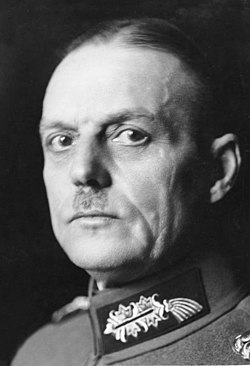Rhineland Offensive
1945 Allied operations in Germany during WWII From Wikipedia, the free encyclopedia
The Rhineland Offensive was a series of allied offensive operations by 21st Army Group commanded by Bernard Montgomery from 8 February 1945 to 25 March 1945, at the end of the Second World War. The operations were aimed at occupying the Rhineland and securing a passage over the Rhine river.[1]
| Rhineland Offensive | |||||||
|---|---|---|---|---|---|---|---|
| Part of the Western Allied invasion of Germany | |||||||
 Churchill tanks at the onset of Operation Veritable, 9 February 1945 | |||||||
| |||||||
| Belligerents | |||||||
|
United Kingdom Canada United States | Germany | ||||||
It was part of General Dwight D. Eisenhower's "broad front" strategy to occupy the entire west bank of the Rhine before its crossing. The Rhineland Offensive encompassed Operation Veritable, Operation Grenade, Operation Blockbuster, Operation Plunder and Operation Varsity.[2]
Opposing forces
Summarize
Perspective
Allies
Forces deployed North to South:[3]: 87 [4]
Allied 21st Army Group
Field Marshal Sir Bernard Law Montgomery
 Canadian First Army
Canadian First Army- Lieutenant General Harry Crerar
- British XXX Corps (Lt Gen Brian Horrocks)
- British 15th (Scottish) Infantry Division (Maj Gen Colin Barber)
- British 43rd (Wessex) Division (Maj Gen Sir Ivor Thomas)
- British 51st (Highland) Division (Maj Gen Tom Rennie)
- British 53rd (Welsh) Division (Maj Gen Robert Knox Ross)
- British Guards Armoured Division (Maj Gen Allan Adair)
- Canadian 2nd Infantry Division (Maj Gen Bruce Matthews)
- Canadian 3rd Infantry Division (Maj Gen Daniel Spry)
- Canadian II Corps (Lt Gen Guy Simonds)
- British XXX Corps (Lt Gen Brian Horrocks)
 British Second Army
British Second Army- Lieutenant General Miles Dempsey
- 79th Armoured Division (Maj Gen Sir Percy Hobart)
- British I Corps (Lt Gen John Crocker)
- British VIII Corps (Lt Gen Evelyn Barker)
- 11th Armoured Division (Maj Gen Pip Roberts)
- 3rd Infantry Division (Maj Gen Lashmer Whistler)
- British XII Corps (Lt Gen Neil Ritchie)
- 7th Armoured Division (Maj Gen Lewis Lyne)
- 52nd (Lowland) Division (Maj Gen Edmund Hakewill-Smith)
 US Ninth Army
US Ninth Army- Lieutenant General William H. Simpson
- 75th Infantry Division (Maj. Gen. Ray E. Porter)
- 95th Infantry Division (Maj. Gen. Harry L. Twaddle)
- US XVI Corps (Maj. Gen. John B. Anderson)
- 8th Armored ("Thundering Herd") Division (Maj. Gen. John M. Devine)
- 35th Infantry ("Santa Fe") Division (Maj. Gen. Paul W. Baade)
- 79th Infantry ("Cross of Lorraine") Division (Maj. Gen. Ira T. Wyche)
- US XIII Corps (Maj. Gen. Alvan C. Gillem Jr.)
- 5th Armored ("Victory") Division (Maj. Gen. Lunsford E. Oliver)
- 84th Infantry ("Railsplitters") Division (Maj. Gen. Alexander R. Bolling)
- 102nd Infantry ("Ozark") Division (Maj. Gen. Frank A. Keating)
- US XIX Corps (Maj. Gen. Raymond S. McLain)
Axis
Oberbefehlshaber West
Generalfeldmarschal Gerd von Rundstedt
Forces deployed North to South:[3]: 86 [5]
- Heeresgruppe H
- Generaloberst Johannes Blaskowitz[a]
- Twenty-Fifth Army
- General der Infanterie Günther Blumentritt
- First Parachute Army
- General der Fallschirmtruppe Alfred Schlemm
- Heeresgruppe B
- Generalfeldmarschal Walter Model
- Fifteenth Army
- General der Infanterie Gustav-Adolf von Zangen
- Fifth Panzer Army
- General der Panzertruppe Hasso von Manteuffel thru 9 Mar, then Generaloberst Josef Harpe
- LXXIV Corps (Carl Püchler)
- LXVII Corps (Otto Hitzfeld)
- LXVI Corps (Walther Lucht)
- Fifth Panzer Army

See also
Notes
References
Further reading
External links
Wikiwand - on
Seamless Wikipedia browsing. On steroids.







